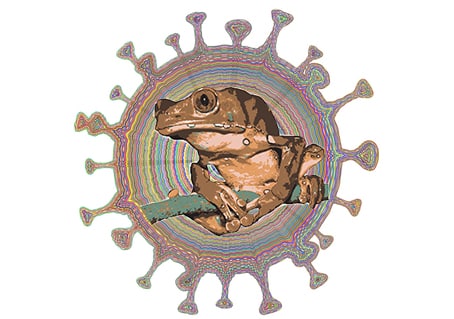Can Kambo Kill Coronavirus?

The world is becoming more unstable with every passing moment. On top of all the economic, political, class, and social instabilities currently shaking the globe producing unprecedented mass anxiety, we also have to worry about invisible health threats (most notably coronavirus!).
Bacterias are increasingly developing resistance to conventional antibiotics, cancer treatments are cytotoxic and often ineffective due to microevolution of the tumor tissue, and viruses are mutating beyond control.
Diseases like the latest COVID-19 pandemic swiftly and woefully demonstrate just how frail our collective immunity really is. As most of us already know, there is no cure for COVID-19 because we barely have any pharmaceuticals to fight viruses to begin with.
The need for novel antibacterial, antitumor, and antiviral medication is becoming dire. Could the answer lie in alternative and traditional medicine?
Kambo: Traditional Frog Medicine
Kambo (sometimes spelled kambô or called sapo) is an indigenous Amazonian medicine used for a variety of healing purposes. If we look at its phenomenological effects, kambo’s main function can appear to be emetic; it produces violent and sustained purging, often from both ends. However, indigenous peoples of Brazil, the Guianas, Venezuela, Colombia, Peru, and Bolivia have been using kambo for relieving pain and inflammation and treating various other medical conditions, possibly for centuries.
While most indigenous medicines come in the form of plants, kambo is actually the toxin of the Phyllomedusa bicolor tree frog, also known as the giant leaf frog. The toxin is obtained from the frog when it’s stressed, which happens once it’s caught and tied up for harvest. The poisonous secretion is scraped off its back and kept on a bamboo stick, and the frog is released back into the wild.
The typical kambo ceremony involves inflicting small dot-like burns on the skin of the participant (commonly on the arms for men and legs for women). The toxin is then reconstituted with spit or water, and a small dose (about 10 mg) is applied to the burns.
Almost immediately, the physical response begins. The heart starts racing, hands start shaking, the headspace starts swelling with pressure, and the purge commences. The peak of the experience can last from ten minutes to a few hours, depending on the amount of medicine applied, how long it’s kept on the wound, and the condition of the participant. The toxin is usually removed after 10-20 minutes, and symptoms tend to subside rapidly after that. The comedown is often followed by a feeling of peaceful euphoria, groundedness, oneness, and gratitude.
Unlike many other natural and pharmaceutical substances, kambo is able to efficiently cross the blood-brain barrier and rapidly produce its effects at the cerebral level. While human bodies contain natural defense mechanisms which break down compounds such as DMT, kambo has a direct pass into our cells.
Kambo Use and Effects
In traditional uses, kambo is applied to cure or prevent pain and illness, to expel ‘panema’ (evil spirits), and even to induce abortions. It would also be taken by hunters before or during the excursions, for sharpening their senses and increasing stamina.
Aside from its traditional indigenous use, kambo has gained massive popularity in the Western alternative healing scene, even making appearances in mass news media (check out this particularly whimsical editorial).
Anecdotal reports of kambo successfully treating pain, autoimmune diseases, skin disease, substance abuse, depression, and even cancer are growing numerous as flocks of trained (and some self-proclaimed) practitioners purvey this medicine around the world. Kambo’s status as a legal substance further helps its global spread.
Typically, kambo is used as a detox. It’s thought by its proponents to help reduce inflammation, boost the immune system, and refresh your body by removing toxins. Although there is not much science to back this up yet, there are all sorts of success stories online, and many people swear my its medicinal effects.
Although kambo is used as a medicine, it’s important to remember that this is a potent toxin whose dangers haven’t been sufficiently scientifically explored; responsibility, experience, and care are prerequisites for serving it. Unfortunately, not all practitioners seem to have these nor to respect or follow traditional indigenous methodology when applying it. It’s true that kambo can be a potentially lethal substance in the wrong hands.
Kambo Contraindications
Avoid using kambo with any heart or blood pressure medication. If you have an anxiety disorder, think twice about using kambo – the rise in heart rate could trigger an anxiety attack. You should also not take kambo if you have Addison’s disease, suffer from severe epilepsy, or take immuno-suppressants. If you’re pregnant, kambo could trigger a painful abortion.
Kambo has a risk of hyponatremia – a potentially fatal imbalance of sodium levels. Make sure you don’t drink more than two liters of water over the course of a ceremony, or drink a small quantity of electrolyte-enriched water to keep your sodium levels high enough.
Finally, remember that kambo also requires permanently scarring your skin. This is yet another reason to make sure you fully trust your facilitator. When choosing a kambo practitioner, make sure to do your research and select someone who comes recommended, and who you feel comfortable with.
The Antimicrobial and Antiviral Action of Kambo
The acute effects of kambo are caused by the many different peptides that make up this toxin. These include Dermaseptins, Phyllokinin, Tryptophilins, Sauvagine, Bombesins, Phyllocaerulein, Phyllomedusin, Adenoregulin, and Deltorphin/Demorphin. Among these peptides, Dermaseptins are scientifically the most interesting and relevant, as their antimicrobial effects reported so far may account in large part for kambo’s purported healing properties.
Dermaseptins are peptides isolated from a number of species of Hylidae, a diverse family of tree frogs. They have been shown to be effective against bacteria, parasites, protozoa, viruses, and even cancer cells. They are likely responsible for protecting the frogs’ bodies from these microbial organisms.
However, it’s highly important to keep in mind that most of these protective actions have only been scientifically demonstrated in vitro. This means experiments have only been conducted outside of the body, in sterile laboratory conditions. There are few in vivo studies with this compound, and, as of yet, no human clinical trials. Therefore, using kambo as an antibacterial, antiviral, or antitumor agent is not a clinically validated and safe decision at this point in time.
With that said, let’s have a look at some of the research that started assessing the antimicrobial and anti-cancer properties of Dermaseptins:
- A study from 1994 described the mechanism of Dermaseptins efficiently permeating microbial membranes, and how they could potentially serve as antifungal and antibacterial agents.
- A study from 2002 is one of the rare animal studies with Dermaseptin. The researchers reported strong antibacterial activity of Dermaseptin S4 in mice infected with the Gram-negative bacterium P. aeruginosa.
- A study from 2007 showed selective in vitro cytolytic activity of Dermaseptin L1 against HepG2 hepatoma-derived cells. This is one of the first studies of the anti-cancer effects of Dermaseptin.
- A study from 2009 used isomers of Dermaseptin S4 and found astounding leaps in in vitro effectiveness against the A. baumannii and P. aeruginosa bacteria. We definitely need more innovative research like this.
- A study from 2013 found potent in vitro antiviral action of Dermaseptin S4 on both acyclovir-resistant and acyclovir-sensitive strains of the herpes simplex virus (HSV-2). Herpes simplex may be one of the first viral infections on which the effectiveness of Dermaseptins will be examined in humans.
- A study from 2017 found that Dermaseptin-PH inhibited the in vitro growth of various Gram-negative and Gram-positive bacteria, and pathogenic yeast Candida albicans. It also showed a broad-spectrum of in vitro anti-cancer activity against several tumor cell types.
- A study from 2019 examined the anti-cancer properties of Dermaseptin-PS1 and found that its mechanism of action seems to depend on the concentration of the glioblastoma cells they were observing.
The volume of personal reports of individuals whose lives were strongly positively influenced by kambo is even more impressive, and the stories can be quite moving. More and more people are getting to benefit from this medicine served by well-vetted practitioners.
So, to Kambo or Not to Kambo?
It’s hard not to be infected with optimism after learning about all these positive results (puns not intended). Still, it’s premature to assume that kambo is a miracle cure. Just because laboratory results show that kambo can kill some bacteria and some viruses, doesn’t mean it can protect you against any infection. It should not be assumed that kambo could protect you from coronavirus!
As always, rigorous scientific research and testing takes time, but is needed to be certain of things like dosages and specific types of compounds that are effective against specific types of conditions. Thankfully, kambo’s legal status should permit this to happen in the near future, especially with the advances indigenous plant medicines have been making recently.
Kambo may well have some protective effects against the coronavirus, but it’s far too early to know for sure, and far too risky to think that using it will mean you no longer have to practice social distancing or wear a mask!


